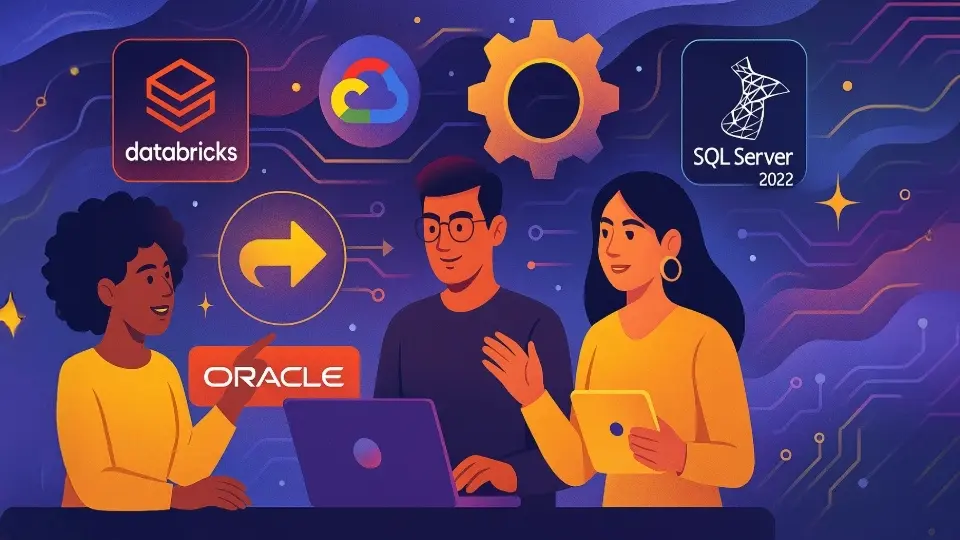Modernize Smarter: Legacy Modernization with Databricks
Unlocking Legacy Data Potential
Enterprises across the Northeast Corridor—from Boston’s biotech firms to New York’s financial institutions and Philadelphia’s healthcare networks—are increasingly seeking ways to modernize legacy systems without disrupting mission-critical operations. The challenge lies in unifying fragmented data sources, enabling real-time analytics, and preparing for GenAI-driven personalization.
Databricks on Google Cloud Platform (GCP) offers a powerful solution to bridge legacy infrastructure with modern cloud-native architectures. By leveraging scalable data engineering, collaborative notebooks, and machine learning capabilities, organizations can transform siloed systems into intelligent, unified platforms.
What Is a Databricks Workspace?
A Databricks workspace is your launchpad for:
Scalable ETL pipelines using Apache Spark
Collaborative development via notebooks
ML model training and deployment
Real-time analytics and dashboarding
This centralized environment empowers data teams to build, iterate, and deploy faster—ideal for high-demand sectors in the Northeast like finance, healthcare, and logistics.
Seamless Integration with Matillion ETL
For organizations using Matillion ETL, integration with Databricks is straightforward. Using the JDBC connector, you can link Matillion’s orchestration layer to your Databricks SQL endpoint, enabling:
Efficient data ingestion
Transformation into Delta Lake format
Streamlined workflows for analytics and machine learning
This setup is especially useful for enterprises managing complex data pipelines across legacy systems and cloud platforms.
Ingesting Data from Oracle and SQL Server
Modernization begins with data ingestion. Databricks supports direct connectivity to legacy databases like Oracle Database Enterprise Edition and SQL Server 2022, enabling seamless migration and transformation.
Ingesting from Oracle:
Use the Databricks JDBC connector to connect to Oracle. Configure the connection with:
Oracle JDBC URL
Credentials stored securely in GCP Secret Manager
Spark’s read.jdbc() method to ingest tables into DataFrames
Once ingested, data can be cleaned, enriched, and stored in Delta Lake, ready for downstream analytics or ML workflows.
Ingesting from SQL Server 2022:
Similarly, Databricks can connect to SQL Server using JDBC. Key steps include:
Setting up a secure connection string
Using Spark to read tables via read.jdbc()
Applying transformations and writing to Delta Lake
This approach allows enterprises to preserve historical data while enabling modern analytics and AI capabilities.
Deploying Databricks via Google Cloud Marketplace
Creating a Databricks workspace on GCP is simple:
Search for Databricks in the Google Cloud Marketplace
Configure your GCP project and select your region (e.g., us-east1 for Northern Virginia)
Deploy and integrate with a GCP bucket using gs:// paths
Assign GCP IAM roles for secure access:
Storage Object Viewer (read-only)
Storage Object Admin (read/write)
Databricks Service Account User (workspace-level access)
These roles ensure compliance and security, especially for regulated industries in the Northeast.
Reverse ETL: Driving Real-Time Personalization
Reverse ETL is a transformative technique that pushes modeled data from your warehouse back into operational systems like:
CRMs (Salesforce, HubSpot)
ERPs (SAP, NetSuite, Sage X3)
Marketing platforms (Braze, Marketo)
This enables real-time personalization by syncing enriched customer profiles, behavioral segments, and predictive scores into frontline tools.
Northeast Use Case:
A retail chain in New Jersey can use reverse ETL to sync customer lifetime value (CLV) scores into its CRM. Sales teams prioritize high-value customers, while marketing platforms trigger personalized campaigns based on recent purchases or browsing behavior.
This closed-loop system turns static data into dynamic, actionable insights—boosting engagement, loyalty, and revenue.
Legacy Modernization with Delta Lake
Databricks enables true legacy modernization by transforming siloed systems into a unified lakehouse architecture. Key benefits include:
Ingesting structured and unstructured data
Schema evolution and data enrichment
Real-time access via Delta tables for BI, ML, or GenAI
This architecture supports scalable analytics and intelligent automation across departments.
Partner with Universal Equations
At Universal Equations, we help enterprises across the Northeast Corridor modernize legacy systems, unify data, and build future-ready architectures using Databricks on GCP. Our services include:
Strategic cloud migration planning
ETL and reverse ETL pipeline development
Oracle and SQL Server data ingestion
GenAI readiness assessments
Whether you're starting your cloud journey or scaling AI initiatives, we tailor solutions to meet your business goals and compliance needs.
Let’s Accelerate Your Transformation
📩 Ready to modernize smarter? Connect with Us to explore how Databricks on GCP can unify your legacy systems and unlock real-time personalization, intelligent automation, and scalable innovation.



